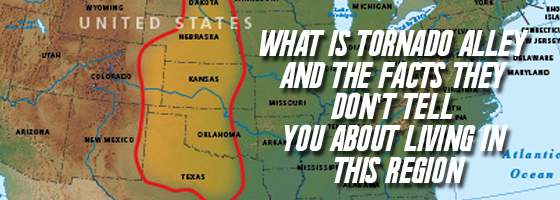What is Tornado Alley and the Facts They Don't Tell You About Living in This Region?
- By Karla Solis
- Jun 7, 2017

Tornadoes occur primarily in the United States, and most of them happen in "Tornado Alley," a stretch of the country that extends from northern Texas through Oklahoma, Kansas and Missouri, and also includes parts of Iowa, Nebraska, Louisiana, and eastern Colorado. The landscape that includes distant mountain borders, and miles of flat plains, combine to create huge, extreme thunderstorms called supercells. Dixie Alley is an offshoot of the north-south Tornado Alley, which spawns huge storms and tornadoes across the South.
The storms are fed by cold dry air from the northwest, which meets up with warm dry air coming up from Mexico and warm, moist air from the Gulf of Mexico.
A NOAA (National Oceanic and Atmospheric Administration) map of tornadoes between 1950 and 2006 shows more than 30 counties in Tornado Alley that had more than 15 strong or violent tornadoes during this time. About 88% of tornadoes are weak, moving slowly, with relatively slow wind speeds. The rest of them are fast-moving, and about 1% are extremely strong violent killers that can and do devastate entire towns.
Enhanced Fujita Tornado Scale
EF0 (65-85 mph) - weak/1-10 minutes
EF1 (86-110 mph) - moderate/1-10 minutes
EF2 (111-135 mph) - strong
EF3 (136-165 mph) - strong
EF4 (166-200 mph) - strong/20+ minutes
EF5 (Over 200 mph) - violent/1+ hour
Facts They Don't Tell You About Tornadoes
• Tornadoes don't hop around. If you see a picture where one home is knocked down and its neighbor is still standing, and then another whole block is wiped out, this is usually from two or more twisters passing through.
• Typical tornado season is most active from April to June, but they can start in February and March. And, different weather conditions can even cause them to crop up in winter, while Dixie Alley has them in the fall months too.
• Opening your windows to "relieve pressure" not only doesn't help, it might cause someone to get to get hurt due to lost time.
• Avoid the freeway overpass. Above all, tell your family members not to stop their car and get out, trying to hide under the overpass. A car or a culvert or ditch is better than the overpass, which can act like a giant wind tunnel to the twister.
• A tornado watch means the weather conditions are right for a twister to get started, but it hasn't happened yet. A tornado warning means that there is one going on or one is imminent and it's time to get into shelter.
• Predictions are getting better. Lots of people used to ignore tornado warnings because the old ones had a 70% error rate. Now, predictions are more accurate and if you hear a warning, accuracy is now up to 70% correct, not wrong.
• The deadliest day in Tornado Alley history occurred in 1925, when 12 different twisters hit a 295-mile strip through Indiana, Illinois and Missouri, killing almost 700 people.
• The U.S. experiences an average of 1,000 tornadoes a year and Oklahoma City is the largest city tornado capital, with more than 100 recorded twisters in city limits.
Prepping for Tornadoes
Make sure you have a plan for what to do if a twister strikes, including how to handle situations where your family could be separated. Make sure your family knows about myths like opening the windows or trying to hide out under an overpass. Check with school, work, church or other location to make sure your family knows where to shelter in place if they are stuck there when a twister hits.
Set up a safe room: if your house has a basement or cellar, prep it and use it. If not, then pick an interior room without windows. Most tornado injuries come from broken glass or other items flying through windows.
How to Handle Problems
A tornado is going to happen if you live in Tornado or Dixie Alley. With the number of unprepared or uninformed people out there, you know that even if emergency services respond right away, you'll be on your own anywhere from 2 to 5 days and potentially longer.
Keep your emergency kit handy, and be aware of after-twister problems, like fire, downed power lines, and leaking gas lines. Your own water stores are going to be the only safe water, and you may have injuries even if you have the most secure shelter possible.
Be sure you have first aid supplies, and it should go without saying: the survival food you will need for yourself and your family for the post-twister days. With your preparation, you know someone else who didn't prepare for tornados might come looking for food. Sharing or trading emergency food with neighbors is one thing, but marauding strangers is another. Be alert and follow family safety plans in this case.

